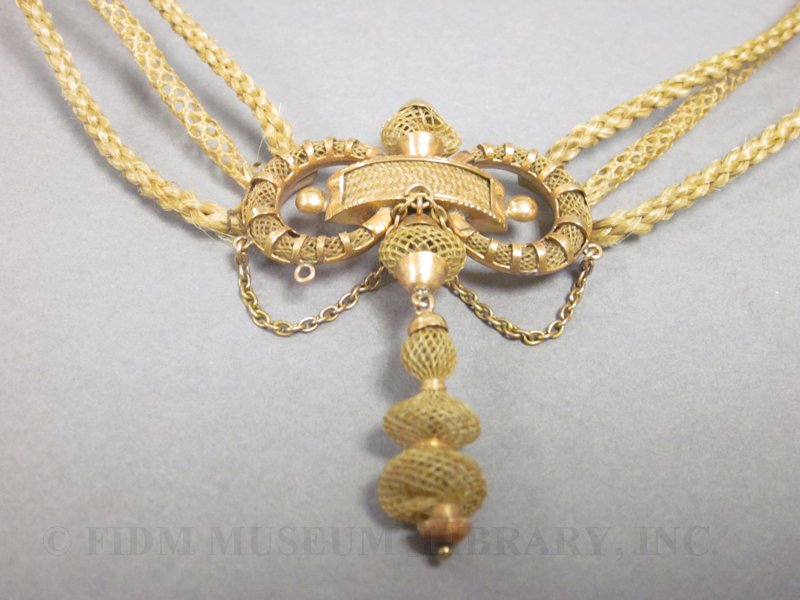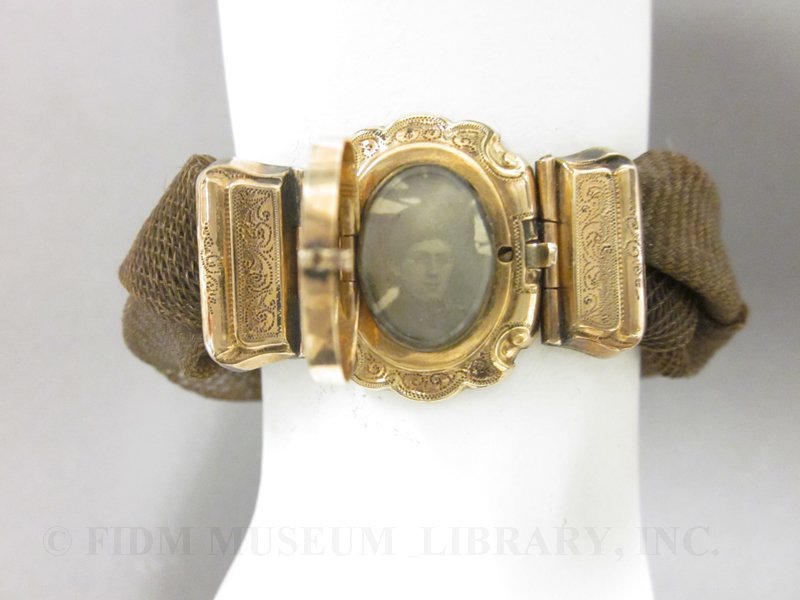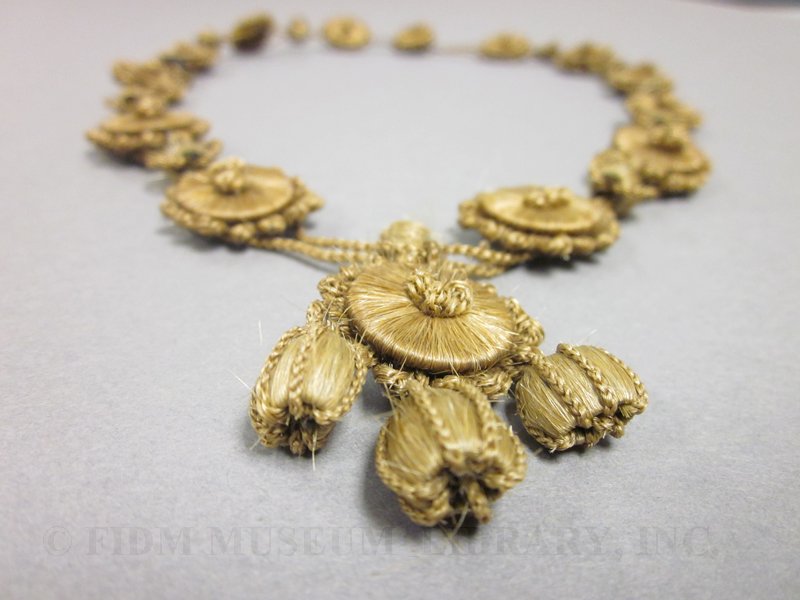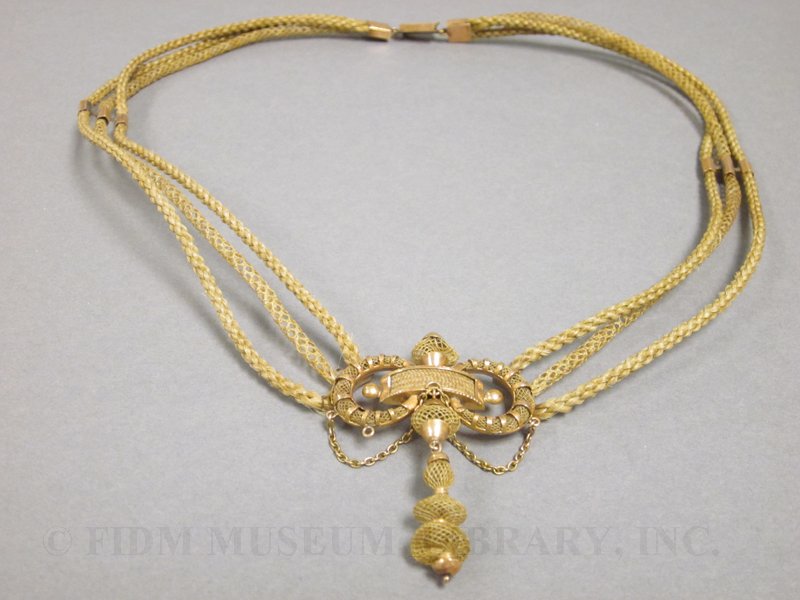"As the hair is the only part of our beloved friends which can be kept in memoriam, it is natural that we should desire to preserve the treasure in some manner that will testify our appreciation of its value…" –Ladies' Fancy Work, 1876.
Locks of hair have long served as sentimental and tangible reminders of deceased or far-away friends and close relations. Among family, friends and romantic partners, exchanging a lock of hair was a sign of mutual esteem and deep affection. Upon the death of a loved one, locks of hair were often cut and kept as a way to both honor and remember the dead. As suggested by the opening quote, hair degrades very slowly if carefully stored. Thus, hair was both an intimately personal souvenir of a specific person and an (almost) everlasting memento. Objects made of human hair also served as memento mori, or reminders of the transiency of human life, for those who wore or owned them.
In its most basic form, a hairwork memento consisted of a snippet of hair enclosed inside a locket or ring. In these instances, the hair was simply stored inside an item of jewelry. There are also examples of hair used as a medium for creating two-dimensional pictorial and abstract images, such as this late 19th century panel featuring both hairwork patterns and an image of the deceased. The most fascinating examples of hairwork consist of elaborate jewelry made almost entirely out of human hair. This type of hairwork jewelry enjoyed peak popularity from the 1850s through the 1880s, dying out almost entirely by the early years of the twentieth-century.
 Hairwork necklace
Hairwork necklace
1850-1890
Gift of Andrea Tice
2008.46.101
In the close-up image of the pendant, you can see pieces of hair which have come loose from the overall structure. This piece is a combination of hairwork forms: circular medallions are accented by a thin strand of braided hair. The entire necklace is even strung on a chain of braided hair! The medallions and bell-shaped pendants were formed by carefully wrapping hair around a solid under structure. This technique forms nearly all non-braided elements of hairwork jewelry.
In mid-nineteenth century American periodicals, intricate hairwork jewelry was identified as relatively recent innovation and a cultural import. As noted in an 1853 article describing a display of hairwork (including a tea set!) at the 1851 Crystal Palace exhibition, "…the old style of wearing a friend's hair in a locket has been common enough from time immemorial, but it is a very modern fashion to so braid and form the hair as to make not only an outside ornament of itself, but also to produce the most beautiful and delicate effect."1 A November 1850 how-to article in Peterson's Magazine called hairwork "a recent importation from Germany."2 Other sources suggest that hairwork jewelry was first created in Norway or Sweden. Regardless of its origins, this form of handwork probably came to North American during the waves of nineteenth century European immigration.
 Hairwork necklace with anchor
Hairwork necklace with anchor
1850-1890
Gift of Andrea Tice
2008.46.111
Hairwork jewelry often incorporated symbolic imagery, such as the anchor seen above. Though finished with gold, both the chain and the anchor are made from hair. Due to their practical function in anchoring boats in harbor, anchors are logically associated with safety. Within Christian symbolism, anchors are also associated with hope. Incorporated into a memorial hairwork necklace, an anchor possibly signified a wish that the deceased and the wearer would meet again in the afterlife.
 Hairwork necklace detail
Hairwork necklace detail
1850-1890
Gift of Andrea Tice
2008.46.106
The hair and gold pendant is in the form of a love knot, symbolizing the fidelity of lovers. This necklace was probably a lover's token and not an item of mourning jewelry.
The manufacture of hairwork jewelry mirrored the arc of nineteenth century industrialization. At the beginning of its popularity, hairwork jewelry was created by skilled craftsmen who usually worked independently or were affiliated with a jeweler. The skill required to work with individual strands of hair is clearly demonstrated by the images above. Operating on a relatively small scale, hairworkers created made-to-order necklaces, brooches, bracelets and other jewelry from the hair of a specific individual, for a specific customer. As hairwork grew more popular, larger jewelers began making hairwork jewelry. When made by a large firm, hairwork jewelry became simply another product to sell, rather than a prized, one-of-a-kind sentimental memento commemorating a loving relationship.
 Hairwork bracelet
Hairwork bracelet
1850-1890
Gift of Andrea Tice
2008.46.424
The band of this bracelet is made of braided hair supporting a gold locket containing a faint image of an unknown woman.
For those interested in hairwork as an at-home handcraft, fashion periodicals published how-to articles on creating hairwork. An 1876 manual titled Ladies' Fancy Work, Hints and Helps to Home Taste and Recreations included hairwork instructions. To get started with an at-home hairwork project it was necessary to procure small scissors, a knife, a spatula and several camel hair brushes, among numerous other items. Materials required included fine wire, liquid gum, india ink and the hair itself. Before use, hair (presumably from a friend or relative, though it was possible to purchase hair) had to be washed and carefully dried to avoid tangling. The hair was then separated into small bundles to be worked into braided chains of various designs. As in making some types of lace, the thin bundles of hair were tied to small weights during the braiding process and worked on a small, round table. Gold finishes, clasps, charms, etc., were purchased from a jeweler.
Given the difficulty of working with such a fine and flighty medium, an interested amateur would have needed hours of practice to complete even a simple hairwork braid. If you're inclined to add hairwork to your repertoire, take a look at Self-Instructor in the Art of Hair Work. First published in 1867, this manual purports to reveal professional techniques for creating both hairwork jewelry and fashionable hairstyles.
1 "Specimens of Hairwork." Gleason's Pictorial Drawing-Room Companion. 8 Oct. 1853: 233.
2 Mlle. Defour. "Hairwork–No. 1" Peterson's Magazine. Nov. 1850: 202.





That looks so cool! I’ve never seen close-ups of this before, though I think I’ve seen a brooch in a museum at one point.
I think there’s a documentary that they aired on/was produced by SVT (Swedish National TV) about some of the girls that made items like this and about their stories and how they were allowed to go to America to promote their art, as told by their grandchildren and families.
As always, a great post!
Thanks Tilde! Glad you enjoyed the post.
The documentary you mention sounds fascinating. Though some sources mentioned Sweden as the originator of hairwork jewelry, I wasn’t able to verify this fact. It would be so interesting to see the documentary you mention.
Wow – that is so interesting! And intricate! I recently found several locks of hair in a Bible at our library and found your blog post in the course of researching why people collected locks of hair. I have quoted a brief passage from this post and cited/linked it in my blog. I hope you won’t mind. Your explanation was so simple and clear; it was really helpful.
Hi Lisa,
It’s great to hear that our post helped you with your research! In researching this post, I also noticed a lack of sources on hairwork. This post was pieced together from both period and contemporary sources. You might be interested in the book “Love Entwined” by Helen Sheumaker. It was the only recent book I found on the subject. Best of luck in our archival endeavors!
Fascinating. Odd, but fascinating! Not sure I would want to wear these items, but boy can I appreciate the artistry.
I would like to see the documentary you are mentioning. It’s so interesting and I would like to know more about this creatively made hairwork jewelry. Those close-up pictures are really rare. I couldn’t believe my eyes because of the awesome artistry. Best luck on your continuing journey, Liza!
I love to see the documentary you mention too. Additionally I am very interested in business website to have brooches made out of hair, I want to have a special souvenir from my daughter’s hair. If you know of any? I remember seeing something like this on the advertisement of Parenting magazine long time ago but can’t find it now
If I didn’t think these were so incredibly beautiful I may find them to be grotesque?! Either way I am in complete awe of the craftsmanship and sentimental valuing of these ornate pieces of history and beauty.
great post! and a great reference book–i have several pieces of hair jewelry, most specifically 2 stick pins that looked like the upper right earring on page 163, that i have made into earrings that look almost identical to that sketch. i used more of the original wire from the pin part to make them dangle more, though. Also have my great-grandmother’s wedding ring, (size 11!) that looks just like #181, page 187.
Never thought i’d see how to make it!
Thanks so much for this great post! I’m working on the subject of hairwork for my MA thesis in art history, and I was wondering if these examples of hairwork from the FIDM collection are currently on display? I’d love to study and write about them!
Hi Rachel,
We don’t currently have any hairwork jewelry on display. You can, however, make a research appointment to come and view some pieces. The pieces featured in this post are only a very small portion of our collection of hairwork jewelry. If you’d like to make a research appointment, contact me via the envelope icon on the upper left portion of the page.
Hairwork is such an interesting topic, but there isn’t much written about it. I’m sure your thesis will be a great contribution to the field.
Thank you for this beautiful post! It is really informative, and I especially appreciate the link to the 1867 hairwork book.
You mention that hair degrades slowly “if carefully stored.” Do you have any advice on how to properly store a collection of hairwork jewelry? Are there any considerations that are specific to hairwork as opposed to other forms of jewelry or other artifacts?
Thank you for your help!
Hi Kristen,
Thanks for your comment. In general, store your hairwork away from direct sources of heat, away from direct light, and keep air pollutants (dust particles, etc.) to a minimum. Hair is susceptible to some insects, so you’ll want to periodically inspect your hairwork to make sure it is free of pests. Try to keep humidity consistent, as spikes in moisture (and temperature) can cause damage.
Obviously, these are very general guidelines! There are some good online resources for storing costume and textiles, which often include info specific to storing natural fibers like wool, silk, and even hair. Try the Canadian Conservation Institute and the Smithsonian Institute. The US National Parks Service also has some good online resources.
Yeah!nice post.All the information is very good.the golden color jewelry is looking so beautiful.Thanks a lot for sharing this.
Wow!very very nice post.It is really so much informative.I am very glad to see this.Thanks for the beautiful post.
I love the anchor necklace and hairwick bracelet. Thanks for sharing the information and pictures!
Hi there,
I love this post! 🙂 I wanted to incorporate it into my senior thesis – a prototype magazine edition that will hopefully become real. I’ll give credits and everything I just think it would be interesting to readers! I want to use the images and text for a story on hair & memory and I was wondering what your policy was? I would love to show other people beautiful work and get people educated about random cool things so please let me know if you are interested and thank you for your time!
Best,
Anara
I am working samples in pearl cotton of each of the braids described in Mark Campbell’s “Self Instructor” mentioned above, and so far I’ve only run across two or three out of the 111 with typos or instructions that I couldn’t work out.
What a thrill to see good close-ups of hairwork contemporary to the book!